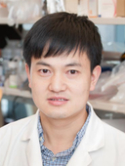| Abstract: |
In metazoan organisms, cell competition acts as a quality control mechanism to eliminate unfit cells in favour of their more robust neighbours1,2. This mechanism has the potential to be maladapted, promoting the selection of aggressive cancer cells3–6. Tumours are metabolically active and are populated by stroma cells7,8, but how environmental factors affect cancer cell competition remains largely unknown. Here we show that tumour-associated macrophages (TAMs) can be dietarily or genetically reprogrammed to outcompete MYC-overexpressing cancer cells. In a mouse model of breast cancer, MYC overexpression resulted in an mTORC1-dependent ‘winner’ cancer cell state. A low-protein diet inhibited mTORC1 signalling in cancer cells and reduced tumour growth, owing unexpectedly to activation of the transcription factors TFEB and TFE3 and mTORC1 in TAMs. Diet-derived cytosolic amino acids are sensed by Rag GTPases through the GTPase-activating proteins GATOR1 and FLCN to control Rag GTPase effectors including TFEB and TFE39–14. Depletion of GATOR1 in TAMs suppressed the activation of TFEB, TFE3 and mTORC1 under the low-protein diet condition, causing accelerated tumour growth; conversely, depletion of FLCN or Rag GTPases in TAMs activated TFEB, TFE3 and mTORC1 under the normal protein diet condition, causing decelerated tumour growth. Furthermore, mTORC1 hyperactivation in TAMs and cancer cells and their competitive fitness were dependent on the endolysosomal engulfment regulator PIKfyve. Thus, noncanonical engulfment-mediated Rag GTPase-independent mTORC1 signalling in TAMs controls competition between TAMs and cancer cells, which defines a novel innate immune tumour suppression pathway that could be targeted for cancer therapy. © 2023, The Author(s), under exclusive licence to Springer Nature Limited. |

















